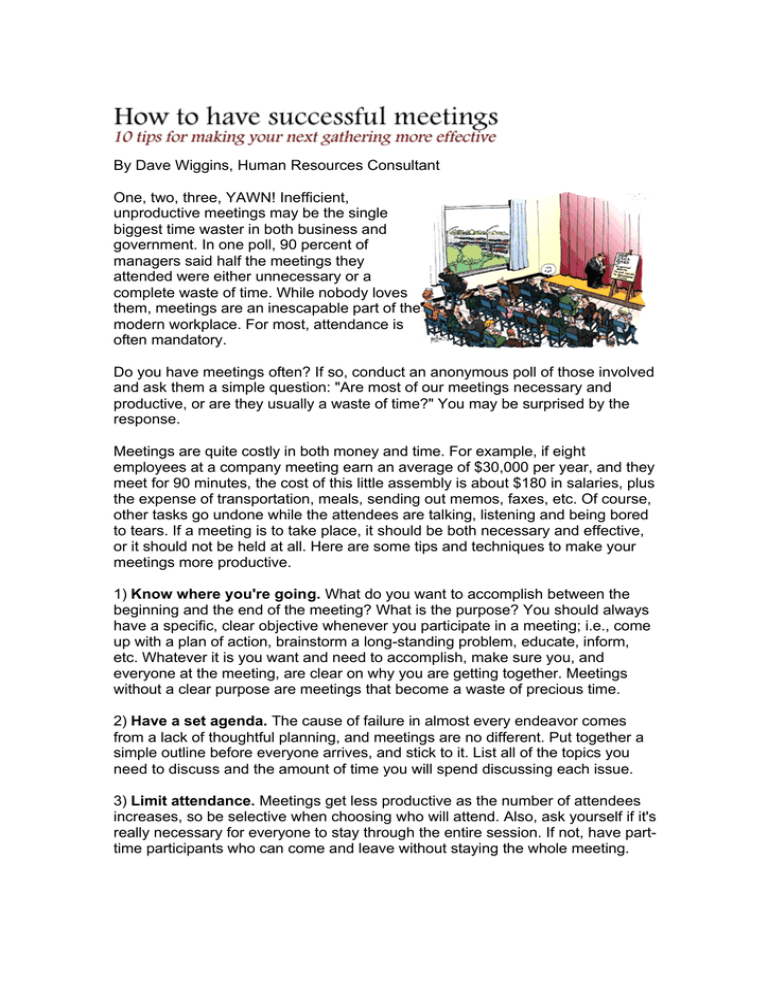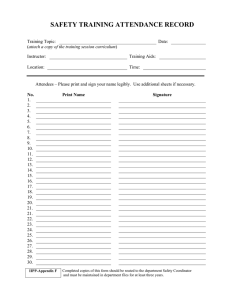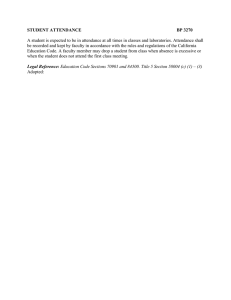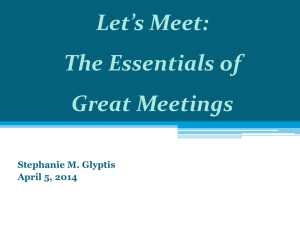By Dave Wiggins, Human Resources Consultant One, two, three, YAWN! Inefficient,
advertisement

By Dave Wiggins, Human Resources Consultant One, two, three, YAWN! Inefficient, unproductive meetings may be the single biggest time waster in both business and government. In one poll, 90 percent of managers said half the meetings they attended were either unnecessary or a complete waste of time. While nobody loves them, meetings are an inescapable part of the modern workplace. For most, attendance is often mandatory. Do you have meetings often? If so, conduct an anonymous poll of those involved and ask them a simple question: "Are most of our meetings necessary and productive, or are they usually a waste of time?" You may be surprised by the response. Meetings are quite costly in both money and time. For example, if eight employees at a company meeting earn an average of $30,000 per year, and they meet for 90 minutes, the cost of this little assembly is about $180 in salaries, plus the expense of transportation, meals, sending out memos, faxes, etc. Of course, other tasks go undone while the attendees are talking, listening and being bored to tears. If a meeting is to take place, it should be both necessary and effective, or it should not be held at all. Here are some tips and techniques to make your meetings more productive. 1) Know where you're going. What do you want to accomplish between the beginning and the end of the meeting? What is the purpose? You should always have a specific, clear objective whenever you participate in a meeting; i.e., come up with a plan of action, brainstorm a long-standing problem, educate, inform, etc. Whatever it is you want and need to accomplish, make sure you, and everyone at the meeting, are clear on why you are getting together. Meetings without a clear purpose are meetings that become a waste of precious time. 2) Have a set agenda. The cause of failure in almost every endeavor comes from a lack of thoughtful planning, and meetings are no different. Put together a simple outline before everyone arrives, and stick to it. List all of the topics you need to discuss and the amount of time you will spend discussing each issue. 3) Limit attendance. Meetings get less productive as the number of attendees increases, so be selective when choosing who will attend. Also, ask yourself if it's really necessary for everyone to stay through the entire session. If not, have parttime participants who can come and leave without staying the whole meeting. 4) Stay focused on the subject at hand. Meetings are always more effective when a leader controls the direction of the meeting and keeps everyone focused on the agenda. Even the best-intentioned participants will start discussing topics unrelated to the issue at hand, and an effective meeting leader will politely stop such digressions quickly. 5) Be prompt! If a meeting is scheduled to begin at 8 a.m., start at 8 sharp, not at 8:05 or 8:10. Some people have a bad habit of arriving late, and to make those who arrive on time wait for those who do not is both unfair and inconsiderate. When people know that your meetings start promptly, they will arrive on time more often. Be punctual and begin every meeting on time, every time! 6) Have a deadline. Meetings should not only begin at a precise time, but end on time, too. Time limits create a sense of urgency, and meeting participants will usually react by concentrating on the issues at hand, avoiding idle chatter, etc. Deadlines will encourage the attendees to be more efficient and effective, especially as the end of the meeting approaches. 7) Schedule intelligently. The best times for meetings are at 11 a.m. and 4 p.m. People are more likely to focus on the subject at hand before lunch and around quitting time. However, try to avoid scheduling meetings right after lunch. Most people experience an energy dip right after a meal, and the larger the meal, the less their ability to pay attention and participate. Also, the best time to schedule a future meeting is at the end of one. Rather than making phone calls and sending letters announcing an upcoming meeting, set a time and place to meet again while everyone is together. 8) Stand and deliver. If you want to have a brief, "no-fluff" meeting that lasts no more than 10 minutes, do not seat yourselves. Have everyone stand during the meeting. There is a correlation between comfort and the length of conversations, and standing up is less comfortable than being seated. 9) Heaven (and everything else) can wait! Never, ever permit an interruption during a meeting unless there is an emergency. Every minute the meeting is disrupted is a minute lost for everyone in attendance. 10) Kill it. Is your next meeting really necessary? The meeting that appears to be essential Monday sometimes loses its urgency by Thursday. If the need for a meeting does not seem as great as it did when you originally planned it, please do everyone a favor. Cancel it! Remember, no one likes meetings, and they will not be angry at you for calling it off. PMR About the author Dave Wiggins is a speaker, trainer and consultant on issues of management, sales, workplace innovation and customer retention. He is the author of Time Management for Busy People: The Crash Course, and two other books on business issues. Wiggins lives and works in Lakewood, Colo. 10 STEPS TO GREAT MEETINGS 1. Know where you're going. 2. Have a set agenda. 3. Limit attendance. 4. Stay focused on the subject at hand. 5. Be prompt! 6. Have a deadline. 7. Schedule intelligently. 8. Stand and deliver. 9. Heaven (and everything else) can wait! 10. Kill it.



